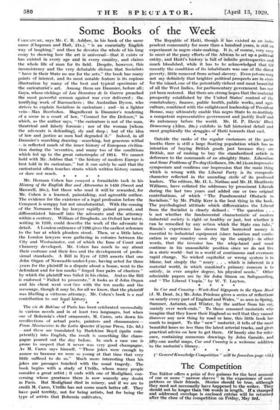Some Books of the Week
CARICATURE, says Mr. C. R. Ashbee, in his book of the same name (Chapman and Hall,- 21s.), " is an essentially English way of laughing," and then he devotes the whole of his long essay to showing how the art is universal—that it exists or has existed in every age and in every country, and claims the whole life of man for its field. Despite, however, this inconsistency and the very debatable dictum that Socialists " have in their State no use for the arts," the book has many points of interest, and its most notable feature is its copious illustration by many of the best and typical specimens of the caricaturist's art. Among them are Daumier, before all ; Goya, whose etchings of Los Desastres de la Guerra preached the most powerful sermon against war ever delivered ; the. terrifying work of Raemaekers ; the Australian Dyson, who strives to explain Socialism in caricature ; and—in a lighter vein—Max Beerbohm. Magnificent is Daumier's rendering of a scene in a court of law, " Counsel for the Defence," in which, as the author says, "the caricature is not of the man, theatrical and falsely forensic ; nor of the woman [whom the advocate is defending], sly and deep ; but of the idea of law and justice as men had degraded it." Indeed, in all Daumier's searching drawing—searching, but generous withal --is reflected much of the inner history of European civiliza- tion during the 'seventies, and many too of the conditions which led up to the great catastrophe of 1914. We cannot hold with Mr. Ashbee that " the history of modern Europe is best told in its caricature," but it can safely be said that the caricaturist often touches strata which written history cannot
or dare not -reach. * '


















































 Previous page
Previous page